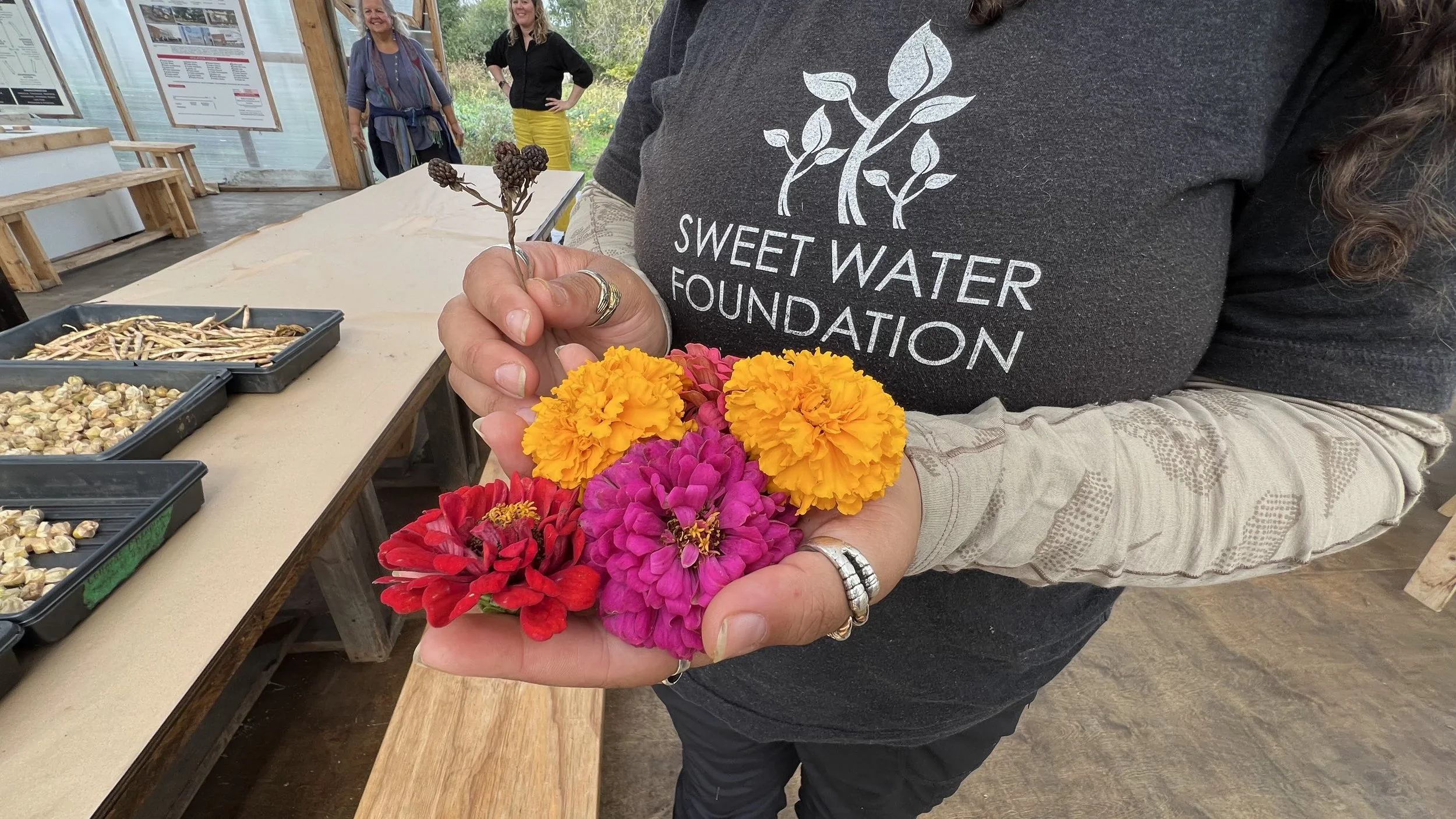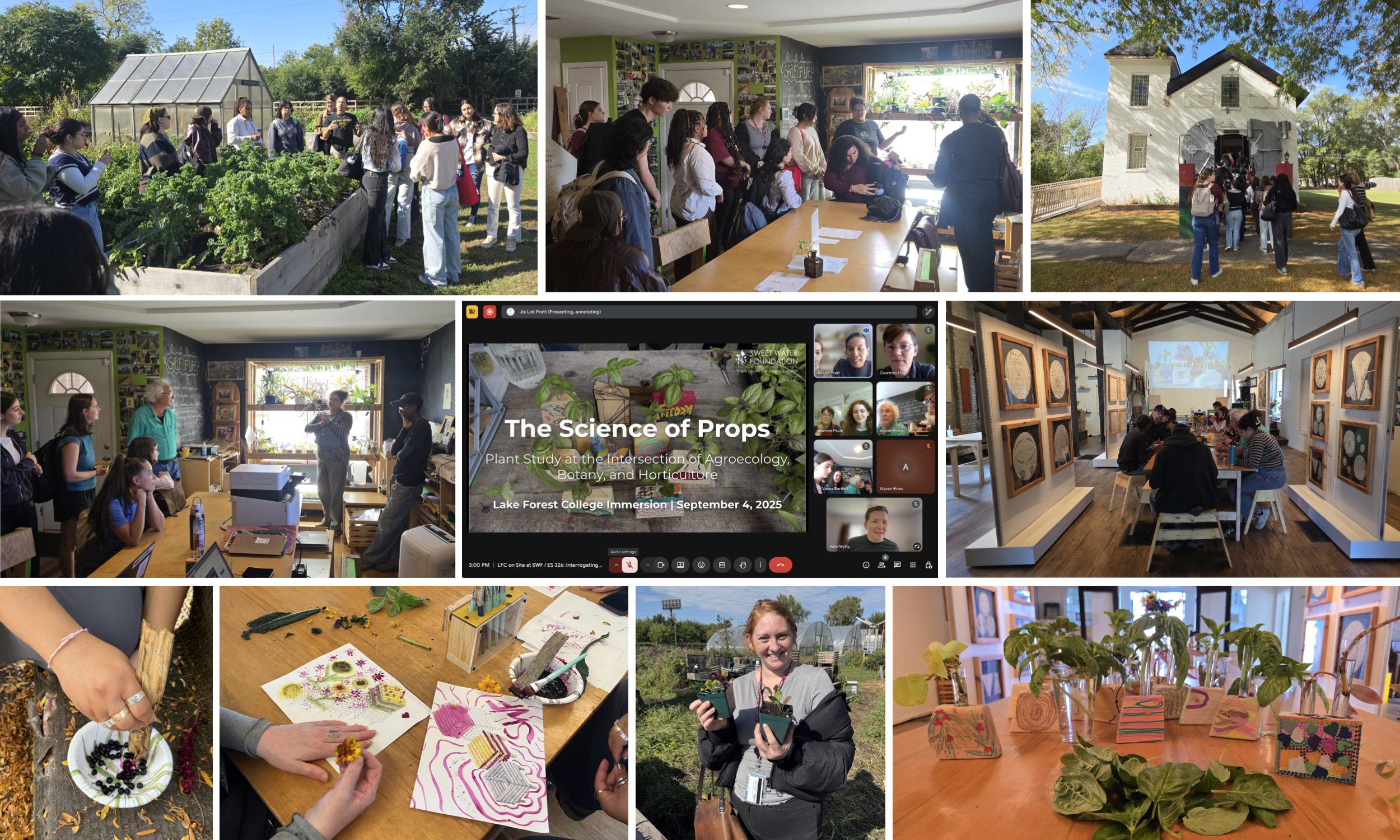2025 Fall at The Common|Wealth
As the harvest season peaked, the focus at The Common|Wealth shifted from peak production and community engagement to reflection, refinement, and knowledge [re]generation. As we continued to cultivate the land and share her bounty through Neighborhood Markets and Civic Arts, fall also marked the onset of a new academic year for the Communiversity, welcoming new cohorts of learners - from fresh-faced, young elementary students from Beasley Academic Center starting the year-long Seeding The Future program to undergraduate and graduate students and faculty engaging in immersions and collaborative courses - seamlessly integrating research and civic arts with sustained community engagement.
Read more about Fall 2025 at The Common|Wealth.
Communiversity Programming
Fall RND Re-Search
The Fall RND Re-Search Cohort consisted of team members, local residents, and fellows from diverse geographical and academic backgrounds, including psychology, architecture, biology, and environmental science. Leveraging their prior Communiversity experiences with Neighborhood Academy and Summer Urban Ecology Fellowships, each member followed an individual pathway, demonstrating how RND is inherently interdisciplinary and transdisciplinary through applied research.
These research pathways explored a diverse range of topics, all of which combined research and action. Neighborhood Fellow and Beekeeper, Jessica, focused on native and non-native solitary bees, combining digital research on seasonal patterns with the installation and activation of a native bee hive for winter observation. SWF Urban Ecology Peer Mentor, Alysse, explored NeuroArts and Education, integrating concepts of child development and somatic healing directly into SWF's Seeding the Future field trips and Communiversity immersions. Designer-in-Residence Jasmine, a recent architecture graduate, challenged conventional architectural representations by connecting 3D modeling of SWF furniture to botanical illustrations and choreography. These efforts resulted in diagrams that became an interactive element at the Neighborhood Market Civic Arts table, where visitors experimented with color and movement to reflect the Market’s dynamism. Finally, Urban Ecology Fellow Syv focused on biocultural resilience and wisdom keeping, dedicating their efforts to supporting the refresh of the Think-Do House Library of [Re]Generative Education and to archiving more than 600 civic arts pieces, thereby preserving the community's collective intellectual and creative assets. This applied approach, where researchers were accountable for integrating their theoretical findings into the fabric of the community, is what makes the work truly regenerative. Their individual explorations simultaneously highlighted the interconnected nature of RND and fostered new connections.
Shelf of Life | Season Extension, Comparative Study, and SWF Collaborative Course
Throughout fall, the Shelf of Life continued its role as a living heuristic – a tangible model for learning, research, and regenerative practice. Building on the summer's successful basil propagation efforts, the Fall season established the Shelf of Life as a critical site for season extension, research, and collaboration.
The Shelf of Life served as a focal point for a multi-site comparative case study across three distinct locations: Think-Do House and [Re]Construction House at The Common|Wealth and lab and greenhouse spaces at Lake Forest College as part of the second year of a collaborative environmental science course entitled, Interrogating the Ecology of Place: From Generative AI to Regenerative Neighborhood Development. This year, the course intensified its practical focus by utilizing the Shelf of Life as a central object of study. This direct engagement moved students beyond theoretical concepts of environmental science, compelling them to gain a profound appreciation for the level of care required for Regenerative Neighborhood Development (RND), and fostering a hands-on reconnection with plants and their local ecology of place.
The SWF Communiversity team led the comparative study of the growth and health of various herbs (basil, mint, thyme, and oregano) and houseplants (coleus) across each location, simultaneously using the Shelf of Life for active, applied research throughout the fall, focused on extending the season for herbs indoors. The team made real-time observations, such as basil leaves yellowing due to nutrient deficiency, and immediately tested potential solutions, including applying targeted nutrients to regain the leaves' color. This investigative process also involved comparing plant health across different growth mediums—soil, water, and water plus nutrient solution—and exploring various propagation methods, such as starting new herbs from seed versus stem cuttings. These real-life, tested techniques were then shared with Lake Forest College students for application within their coursework, demonstrating the value of SWF's iterative, place-based research. By mid-October, both the Think-Do House and [Re]Construction House shelves were dedicated to a variety of potted herbs, extending the season and providing more than 60 cups of fresh basil, which were harvested for meals and teas through the end of the year.
Immersions at The Common|Wealth
Fall momentum of Sweet Water Communiversity attracted numerous hands-on immersions from classrooms, groups, and individuals. These experiences were designed to shift perspectives, moving participants toward an understanding of the immense possibilities inherent in SWF’s practice of Regenerative Neighborhood Development and The Common|Wealth as a bio-dynamic campus.
Each immersion followed a core path, with essential elements that included an introduction to "Re-Mapping the Publics” exhibit in the Thought Barn, hands-on interaction with agroecology on the Community Farm and Community Gardens, and a mini-lesson on the regenerative possibilities of the "Shelf of Life." Each immersion concluded at Civic Arts Church with reflection and a civic arts activity, integrating the abundance of The Common|Wealth - bright pink Pokeberry ink or golden marigold “crayons” - into creative expression and healing.
This season included visits from two MacArthur Fellows: Robin Wall Kimmerer and Reuben Jonathan Miller. Kimmerer's focus on Indigenous wisdom and Traditional Ecological Knowledge (TEK) deeply resonates with SWF’s work, and her books/writings, including Braiding Sweetgrass, Tallgrass, and The Serviceberry, among others, are actively integrated into the SWF Communiversity curriculum. During her visit, Robin expressed interest in collaborating and connecting her "Plant Baby Plant" initiative with Sweet Water Foundation. Reuben Jonathan Miller, a sociologist, criminologist, and social worker who has visited several Neighborhood Markets, brought ~25 students enrolled in his class on Race, Crime, and Justice at the University of Chicago, stating that, “SWF’s practice is the answer to many of the issues that we raise in class.”
Students and faculty from the SWF/Lake Forest College collaborative course also took part in an on-site immersion, during which they toured The Common|Wealth and learned about propagation from Sweet Water Academy and Neighborhood Academy participants. Their immersion concluded with propagating basil and painting Prop Blocks in Civic Arts Church to activate their Shelf of Life research on campus, ensuring these immersive experiences immediately translate into future connection points and deeper learning.
Seeding the Future
The Fall marked the launch of the new academic year for Seeding the Future (STF), SWF’s Urban Ecology program that engages elementary students from Beasley Academic Center in hands-on, project-based learning that follows the seed-to-table cycle. This year, SWF welcomed third- and fourth-grade classrooms, many of whose students were excited to return, having participated in STF as second graders. The overarching theme for the year is Regeneration, building upon previous years’ lessons and integrating with Sweet Water Communiversity's focus in 2025.
In September, field lessons focused on Regeneration through Solar Energy, Composting, and Plant Propagation. Students explored how plants and humans utilize the sun's energy, enjoying a Green Sun Smoothie made with solar power. They learned how decomposition regenerates waste into soil by contributing scraps to the compost pile, including the kale stem and banana peel scraps from their smoothie. Students then engaged in hands-on propagation, creating their own "Props" (plant cuttings from basil and mint) after observing the different lifecycle stages on the Shelf of Life, using Prop Blocks as canvases for art and stations for their cuttings. In October, lessons shifted to seasonal change and the study of geophytes—perennial plants that store energy underground. Students investigated this by dissecting onion bulbs and planting tulip bulbs. They also practiced seed saving from annual plants like marigolds and ground cherries, and observed how their September cuttings were now thriving in the soil. Finally, students created Civic Arts using Nature Paints made from kale, marigolds, and chard, and utilized geophytes as stamps for creative expression.
The lessons for STF are not developed in isolation; they are inspired and bolstered by the Sweet Water Communiversity ecosystem. The Sweet Water Academy homeschool program, which integrates traditional school disciplines with hands-on urban ecology research, serves as the Communiversity's internal translator of complex subjects and systems. The Academy shared its weekly research – focused on Plant Study at the Intersection of Agroecology, Botany, and Horticulture – with the broader team. Their findings, covering concepts like geophytes and propagation, are translated into the hands-on, accessible activities shared with Seeding the Future students. Research conducted by the RND Re-Search Cohort also directly influenced the STF experience this fall through the incorporation of art, movement, and healing correlated with the NeuroArts and somatic therapy research and the integration of regenerative architecture and Civic Arts via the use of Prop Blocks and natural pigment arts. This continuous feedback loop ensures that STF lessons are integrated into every essential element of Regeneration happening each season at The Common|Wealth.
Civic Arts and Neighborhood Market
Fall was also dedicated to sustaining the spirit of regeneration and community through the Neighborhood Market, which formally ran through the end of October, although informal produce pick-ups and gatherings continued until December. After Labor Day, Neighborhood Market moved to the Community Garden, becoming a lively hub where the vibrant colors of seasonal produce—tomatoes, peppers, and greens—matched the energy of weekly re-connections.
The Civic Arts table served as the site where wisdom keepers and elders shared their cultural knowledge and lived experiences while bean shucking, recipe sharing, and painting with pigments created from natural materials like marigold flowers and kale. Inspired by the abundance of marigold and zinnia flowers at The Common|Wealth (many seeded by Seeding the Future students in May), the community established a new ritual: gathering, sharing, and brewing herbal teas from the harvested flowers and plants. This tradition, shared by a key SWF elder, further embodied the deep connection between cultivation and community.
This season culminated in the final Neighborhood Market featuring a Civic Arts Talk with Dr. Imani Perry. Her discussion in the Thought Barn shared research on pioneers such as Virginia Estelle Randolph, George Washington Carver and Clinton Calloway, detailing the intentional care and rigor that laid the cornerstones of education in rural Black communities. Her message affirmed that their holistic models—where education and work products became the regenerative node for the entire community—are the very foundation of SWF’s epistemology of Regenerative Education.
Additionally, SWF designed and installed the second exhibit at the Civic Arts Church: Poiesis: Coming Into Being at The Common|Wealth, which brings to life SWF's Portfolio of Possibilities, showcasing designs, spaces, and places across The Common|Wealth that SWF has designed and activated over the last decade. Unlike abstract architectural renderings, this exhibit highlights the real-life actions and people whose collective work regenerates the neighborhood.
Community Farm
Throughout fall, the land at the heart of The Common|Wealth, the Community Farm, guided our practice, embodying continuous regeneration and showing us the way. Through phenology (the study of cyclical and seasonal natural phenomena), we observed unseasonably warm weather that allowed hot crops, like tomatoes and peppers, to stay with us several weeks longer than usual, an extended gift of abundance. Yet, the land also carried the essential lesson of transition and foresight. With intentionality—a hallmark of Regenerative Education—the hoop houses were seamlessly transitioned from summer producers to winter providers of sustenance, prepared to nourish the team and neighbors during the coming cold season. By preparing the soil and structures, the Fall completed the yearly cycle, closing the season of harvest while simultaneously seeding the promise of the next, showing us that the work of renewal is endless.









